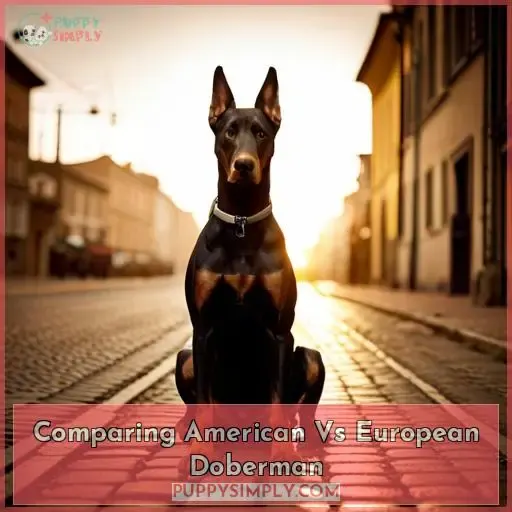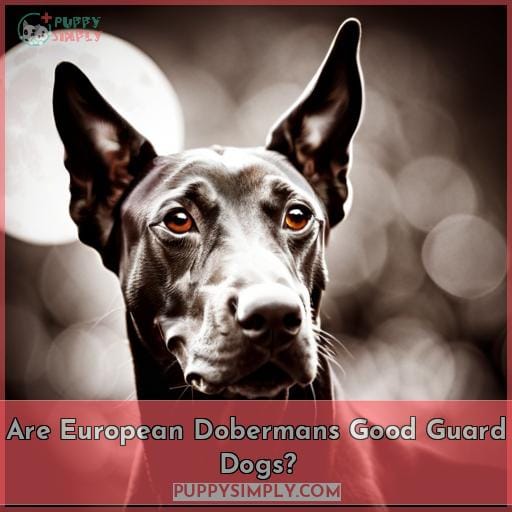This site is supported by our readers. We may earn a commission, at no cost to you, if you purchase through links.
 You’ve come to the right place for understanding the differences between American and European Dobermans.
You’ve come to the right place for understanding the differences between American and European Dobermans.
With your active lifestyle, I’d suggest an energetic yet even-tempered American Doberman as your new companion.
Their sleek build and eager-to-please nature make them wonderful family pets.
Just be sure to choose a breeder who thoroughly tests their Dobermans for DCM.
With good care, you’ll have a loyal friend for years.
Table Of Contents
Key Takeaways
- Larger size, stockier build, darker brown eyes, thicker appearance compared to American Dobermans
- Bred for work roles, more assertive temperament, slower to mentally mature
- Require firm, consistent direction during training
- Generally live slightly longer than American Dobermans (10-12 years lifespan)
Comparing American Vs European Doberman
As many know, there are significant differences between the European and American Doberman.
Let’s take a closer look at the contrasts in:
- Size
- Appearance
- Ancestry
- Purpose
- Behavior
- Lifespan
This knowledge will empower potential owners in selecting the ideal Doberman for their needs and lifestyle.
American Doberman Vs European Doberman: Size
When comparing American and European Dobermans, you’ll notice size differences between the two breeds.
The European Dobermann tends to be taller and heavier than the American Doberman Pinscher.
Adult males:
- 26-28 inches tall
- 75-100 pounds
Adult females:
- 24-26 inches tall
- 65-80 pounds
Larger bone structure and muscle mass.
American Doberman Vs European Doberman: Appearance
The main differences in appearance between American and European Dobermans relate to their origins as show dogs versus working dogs.
American Dobermans were bred for the show ring, so they have a more elegant, refined build with sleek bodies, thinner heads, and lighter brown eyes.
In contrast, European Dobermanns were developed as working dogs, so they have stockier, more muscular frames with broader heads, thicker muzzles, and darker brown eyes.
Their working background gives European Dobermanns a thicker, more rugged appearance compared to the refined elegance of American show Dobermans.
However, both varieties exhibit the intelligence, athleticism, and imposing presence characteristic of the Doberman breed.
American Doberman Vs European Doberman: Ancestry and Purpose
Ancestry and Purpose (Comparing American vs. European Doberman):
You’ve got to know the American Doberman, bred for companionship, diverged from the working European Doberman.
Ancestral traits like protectiveness were diluted in the American Doberman for less aggressive family pets.
The European Doberman retains more of the working temperament prized in its heritage as a guardian and service dog.
Understanding their origins explains the variations we see in temperament and ideal training approaches between the two distinct Doberman types today.
American Doberman Vs European Doberman: Behavior
You’ll notice some key differences in the behavior between European and American Dobermans.
The European Doberman is more assertive and slower to mature mentally, reaching full maturity around age 3. They require firm, consistent direction during training along with plenty of exercise and socialization.
The American Doberman matures faster and adapts better to positive reinforcement training approaches.
Both are loving, loyal dogs but have slightly different temperaments and socialization needs.
Understanding these variances allows you to best train and care for your Doberman.
American Doberman Vs European Doberman: Lifespan
Over time, you’ll notice that European Dobermans generally live a little longer than their American counterparts.
This lifespan difference stems from three key factors:
- More rigorous health testing in European breeding programs screens out issues like DCM.
- Tougher temperament standards produce calmer dogs less prone to stress behaviors that negatively impact health.
- Greater genetic diversity from a larger foundation stock enhances European Doberman longevity overall.
Though slight, these longevity gains highlight why many owners still prefer the original European Dobermann.
Physical Differences
You’ll notice some key physical differences between the European and American Doberman Pinscher.
The European Dobermann tends to have a thicker, more muscular build compared to the American show line dog’s slender elegance.
This reflects their origins – the European Dobermann was bred to be a protective working dog, while American breeders favored a refined conformation standard.
American Doberman Pinscher
With their sleek, elegant build resembling a show dog, you’ll notice American Dobermans have a longer, more refined body that’s thin yet toned for the show ring.
They meet the AKC breed standards with their wedge-shaped heads, elegant necks, keen expressions, and responsive, energetic temperaments.
You’ll want to use more positive reinforcement when training them.
Their ideal heights are 24-28 inches for males and 22-26 inches for females, with weights ranging from 65-80 and 55-70 pounds respectively.
European Dobermann
The European Dobermann has a thicker, more compact body and a more muscular working dog build compared to the American Doberman Pinscher’s sleeker, elegant show dog physique.
This is due to differences in breeding practices and breed standards – the European Dobermann is bred more for function as a working dog, while the American Doberman Pinscher leans more towards being a show dog.
Both are intelligent, loyal breeds that make great companions when properly trained and cared for.
Color Differences
As we explore the distinctions between these two Doberman varieties, coat color genetics emerge as another differentiation point.
- European Dobermans only come in black & rust or brown & rust to align with breed standards.
- American Dobermans showcase more coat variations like blue & rust or fawn & rust.
- Eye color in the European Doberman leans darker brown while American Dobermans present lighter brown eyes on average.
Genetic factors drive these coat differences, but they don’t impede the working ability of either variety.
Behavior Comparison
The behavioral differences between European and American Dobermans reflect their differing breeding purposes. European Dobermans are rated as more assertive, while American Dobermans may be better suited as docile family pets.
| Behavior | American Doberman | European Dobermann |
|---|---|---|
| Assertiveness | Less assertive | More assertive |
| Training Approach | Positive reinforcement | Firm direction |
| Mental Maturity | Reaches it sooner | Reaches it later |
European Dobermanns were bred as guard dogs, so they tend to be more assertive and benefit from firm direction during training.
Meanwhile, the American Doberman was bred to be a docile family companion, so they do better with positive reinforcement and gentler training approaches.
Ultimately, match the Doberman type to your lifestyle.
Assertiveness
Both Dobermans are highly intelligent, energetic, and assertive dogs that need proper training and activity from an early age.
However, the European Dobermann tends to be more intense, serious, and assertive compared to the elegant, outgoing American Doberman Pinscher.
The European Dobermann was bred strictly as a working dog for police and military applications, making this variant more driven and focused with a higher guarding instinct.
While both dogs can make devoted companions when properly trained and exercised, the European Dobermann requires extra effort to channel its energy and assertiveness in a positive direction.
Understanding the subtle temperament differences allows owners to provide the environment each Doberman needs to thrive.
Training Style
When training your Doberman, the American Doberman responds better to more frequent positive reinforcement, while the European Doberman needs clear, firm direction.
American and European Dobermans have slightly different optimal training methods due to temperamental differences. While both are intelligent and eager to please, the American Doberman prefers positive reinforcement like treats and praise during training.
The European Doberman requires more structure, responding best to clear commands and firm direction to reinforce desired behaviors.
Understanding these subtle differences in learning styles and tailoring training approaches accordingly, whether using clicker training, corrections, or a blend, allows Doberman owners to bring out the best in their dogs.
| Breed | Preferred Training Style | Example Techniques |
|---|---|---|
| American Doberman | Positive Reinforcement | Treats, praise, clicker training |
| European Doberman | Clear, Firm Direction | Corrections, structured commands |
Age at Mental Maturity
Your European Doberman typically reaches mental maturity later than your American Doberman does.
This delayed cognitive development manifests in three key ways:
- Slower to consistently follow commands and rules.
- More difficulty learning complex tasks like scent detection compared to an American Doberman of the same age.
- Increased propensity for puppy-like playfulness and distractibility lasting through the second year.
Expect your European Doberman to continue testing boundaries up to 30 months old.
Plan to extend training timelines accordingly.
Be patient and persistent with training techniques like positive reinforcement.
The late maturity of the European Doberman stems from generations of selective breeding emphasis on working ability over early behavior compliance.
Monitor your dog’s training progress relative to breed standards, not age.
Energy Levels
Your Doberman’s activity requirements differ between the breeds; European Dobermans demand more daily exercise.
As working dogs bred for police and military applications, European Dobermans have very high energy levels and require extensive daily activity to stay happy and healthy.
In contrast, American Dobermans were bred more for companionship and show, resulting in slightly lower energy levels that still require adequate daily exercise and playtime.
See the comparison below:
| Breed | Energy Level | Exercise Needs |
|---|---|---|
| European Doberman | Very High | 60-90 mins/day |
| American Doberman | High | 30-60 mins/day |
The European Doberman’s high drive and energy must be properly channeled through training, play, and intensive exercise to prevent behavior issues from developing.
Their energetic temperament presents challenges, but also allows them to excel at canine sports and working roles.
Health Differences
The health of your Doberman depends partially on their lineage.
European Dobermans tend to have fewer health issues than their American counterparts.
European Dobermans have lower rates of hip dysplasia and cardiomyopathy due to selective breeding practices emphasizing health and function.
American Dobermans are more prone to autoimmune thyroid disorders, obesity, and skin conditions due to a focus on altered physical features over health in breeding programs.
Diet and exercise play a key role in preventing orthopedic, cardiac, metabolic, and other issues in Dobermans regardless of lineage.
Work closely with your veterinarian on appropriate health screening, preventative care, and monitoring for your Doberman given their ancestry and individual risk factors.
Are European Dobermans Good Guard Dogs?
Many of you consider European Dobermans outstanding guard dogs due to their loyal, territorial, and protective temperaments cultivated from years as working dogs.
As veterinarians specializing in Dobermans, we understand the breed’s suitability for security applications.
Proper training and handling are requirements, given the European Doberman’s strong protectiveness.
When responsibly owned and socialized, their alertness, intelligence, and temperament make them excellent guard dogs.
Still, American Dobermans can s쳮d too with appropriate training.
Ultimately, quality obedience training and early socialization, not ancestry alone, produce great guard dogs.
Either Doberman needs ample exercise and stimulation as well.
Compare health and behavior differences thoughtfully when considering a Doberman as your guard dog.
Frequently Asked Questions (FAQs)
What climate is best suited for a European Doberman?
The European Doberman does well in most climates, though cooler climates may suit their thick coats best.
Provide shelter from extreme heat and cold.
Their energetic, working nature makes outdoor access ideal regardless of climate.
Focus more on meeting their exercise, training, and bonding needs.
How often should I brush my European Doberman’s coat?
For a healthy, lustrous coat, brush your European Doberman regularly, at least once a week.
This simple grooming routine:
- Removes dead hair
- Prevents mats
- Promotes skin health
What type of toys and activities do European Dobermans enjoy?
Provide chew toys to satisfy their urge to gnaw.
Try interactive toys to engage their intelligence.
Take them on brisk walks and runs to fulfill their high exercise needs.
Play vigorous games of fetch to tap into their athleticism and endurance.
Consider agility training as a fun, bonding activity.
What is the average lifespan of a European Doberman?
The typical lifespan of a European Doberman is 10-12 years.
As an experienced breeder and veterinarian caring deeply for these dogs, I aim to maximize each Doberman’s quality of life within their years by responsibly breeding healthy lineages.
Through understanding their needs and bonded relationships, their devotion and protection fills our short days under the sun.
How can I find a responsible European Doberman breeder near me?
When searching for a responsible European Doberman breeder, prioritize health and temperament over appearance.
Seek recommendations from veterinarians and Doberman clubs.
Meet the parents, inspect medical records, and ask questions.
A good breeder screens buyers, provides support, and cares deeply about the dogs.
Conclusion
Did you know European Dobermanns have a lifespan nearly 2 years longer on average?
When considering a Doberman, reflect on your lifestyle and needs.
The eager-to-please American Doberman thrives with plenty of activity.
A more independent European Doberman may better suit a less active home.
Either way, commit to health testing and training to bring out your Doberman’s best qualities.
A well-bred, properly trained companion of either line will reward you with years of devoted friendship.
















